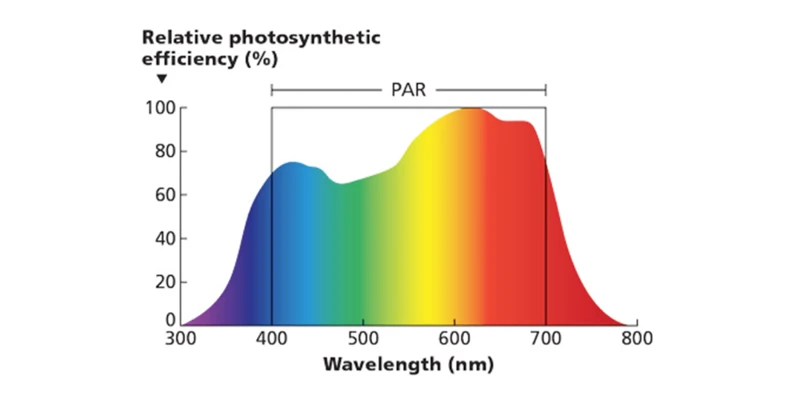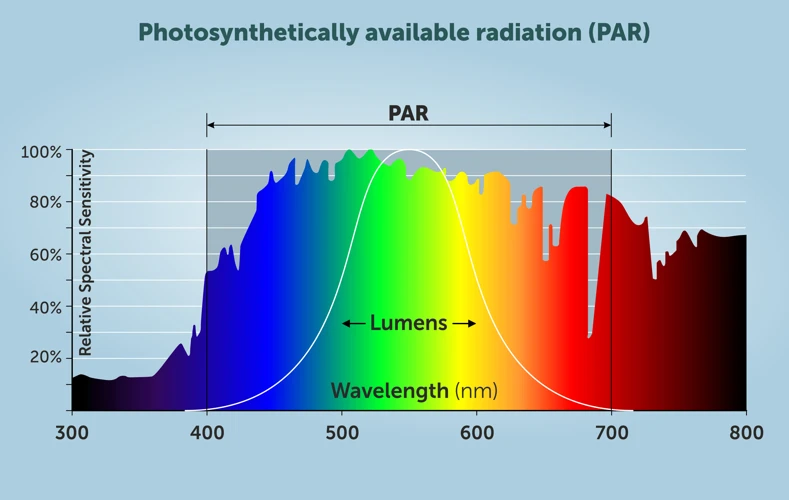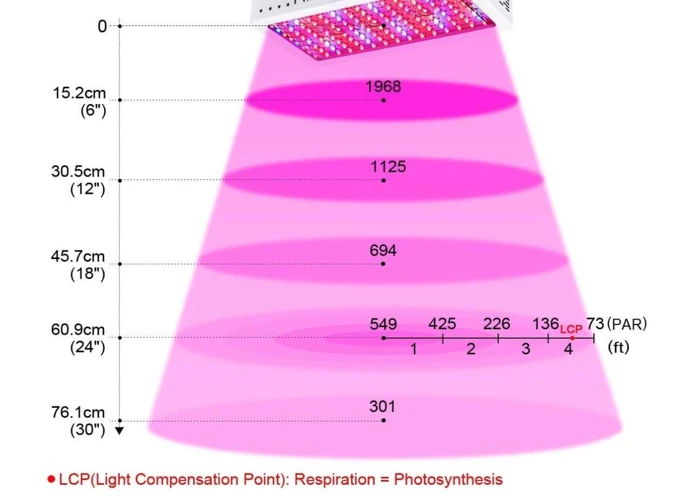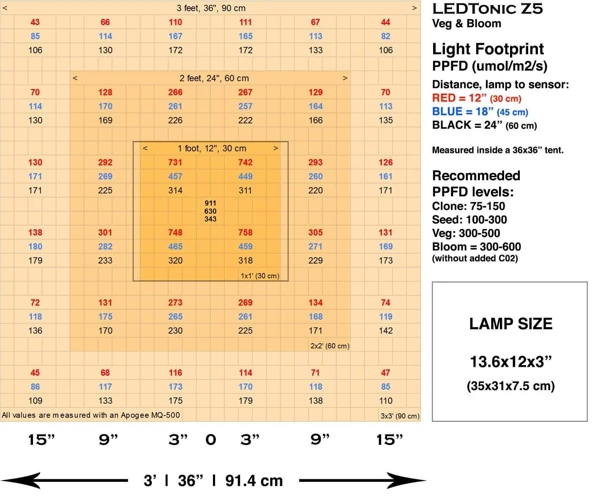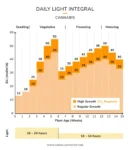
How to Use PAR and PPFD Values to Select the Best Grow Lights for Cannabis Cultivation
Cannabis cultivation can seem like a complex and daunting undertaking, especially for those new to the process. One important aspect of successful cannabis growth is understanding the significance of PAR and PPFD values. These two terms are essential for measuring and determining the optimal growth conditions for cannabis plants. While the jargon might cause confusion for beginners, it’s an essential subject to master, and this comprehensive guide is here to help you understand the concepts of PAR and PPFD, how to measure them, and their significance in the cultivation of cannabis. So, let’s delve into the world of PAR and PPFD values and uncover why they’re crucial for cannabis cultivation.
What are PAR and PPFD Values?
Contents
When delving into the world of cannabis cultivation, it’s essential to understand the terminology and metrics used to measure plant growth and optimize yields. Two terms that are often mentioned within this context are PAR and PPFD values. PAR, or Photosynthetically Active Radiation, measures the spectral range of radiation that plants use during photosynthesis, while PPFD, or Photosynthetic Photon Flux Density, measures the intensity of light that plants receive. It’s essential to have a good grasp of these values to optimize cannabis cultivation and increase your chances of success. Let’s take a closer look at what PAR and PPFD values entail and how they relate to cannabis cultivation.
What is PAR?
PAR, or Photosynthetically Active Radiation, is a type of light that is essential for plants to grow and photosynthesize. PAR is the range of light wavelengths that falls between 400 and 700 nanometers (nm), which is the spectrum of light that plants use for photosynthesis.
PAR plays a crucial role in cannabis cultivation, as it is the light that fuels the plant’s growth and the production of trichomes, which contain THC and other cannabinoids. Without sufficient PAR, cannabis plants will not produce high-quality buds.
To understand PAR better, we can take a closer look at its spectral distribution. PAR is broken down into three sub-ranges:
- Ultraviolet-A (UV-A) (315-400 nm)
- Visible Light (400-700 nm)
- Far-red (700-780 nm)
The visible light range is further divided into six sub-ranges, each with a specific color:
| Sub-range | Color |
|---|---|
| 400-450 nm | Violet |
| 450-500 nm | Blue |
| 500-570 nm | Green |
| 570-590 nm | Yellow |
| 590-620 nm | Orange |
| 620-700 nm | Red |
Each sub-range of PAR has a different effect on the cannabis plant. For example, blue light (450-500 nm) stimulates vegetative growth, while red light (620-700 nm) promotes flowering.
PAR is the range of light wavelengths that plants use for photosynthesis, and it is crucial for cannabis cultivation as it is the light that fuels the plant’s growth and the production of trichomes. Understanding PAR and its sub-ranges is essential for selecting the right grow lights and optimizing cannabis cultivation conditions.
What is PPFD?
PPFD stands for Photosynthetic Photon Flux Density, which is a measurement of the amount of usable light that is available for plants to perform photosynthesis. Plants have certain wavelengths of light that they require in order to grow and thrive, and PPFD measures the amount of light that is within those wavelengths. PPFD is typically measured in micromoles per square meter per second (µmol/m²/s) and is a more accurate measurement of the light that plants receive than lumens or lux, which only measure the brightness of light as perceived by the human eye.
To understand PPFD, it’s important to understand that not all light is created equal. While our eyes perceive all colors of light as the same brightness, plants are more sensitive to certain colors of light than others. Specifically, plants require blue and red wavelengths of light to grow, with red light being especially important during the flowering stage. PPFD takes into account the wavelengths of light that plants use and gives growers a more accurate measurement of the amount of light that plants are receiving.
The amount of PPFD that plants require varies depending on a number of factors, including the type of plant, the stage of growth, and the desired yield. It’s important for growers to monitor PPFD levels to ensure that their plants are getting sufficient light to grow and thrive. If PPFD levels are too low, plants may not grow as quickly or produce as much as they could with optimal light. On the other hand, if PPFD levels are too high, plants may become stressed and damage may occur to leaves and buds.
PPFD is a crucial measurement for growers to understand in order to optimize their lighting setup for cannabis cultivation. By measuring PPFD levels and choosing the right grow lights, growers can ensure that their plants receive the right amount and type of light to produce a healthy and bountiful harvest.
What is the Relationship Between PAR and PPFD?
PAR (Photosynthetically Active Radiation) and PPFD (Photosynthetic Photon Flux Density) values are closely related and often used in conjunction with one another to measure the quantity and quality of light available to plants for photosynthesis. PAR is the range of light wavelengths that are between 400 and 700 nanometers (nm) and that plants use for photosynthesis, while PPFD measures the density of photons in that same range.
The relationship between PAR and PPFD can be explained as follows: PAR is the quantity of light available for photosynthesis, and PPFD is the measure of how many photons in that PAR range actually reach the plant’s leaves. Essentially, PAR is the total amount of light available to the plant, while PPFD measures the intensity of light that the plant is actually receiving.
To put it simply: PPFD measures the number of photons that reach the plant and PAR measures the range of wavelengths that the photons fall within.
The relationship between PAR and PPFD is crucial to understanding how cannabis plants utilize light for photosynthesis. To achieve optimal growth and yield, cannabis plants require a specific range of PAR and PPFD values. The PPFD values tell us how intense the light is in a specific area, while the PAR values tell us how much total light is available.
PAR and PPFD values work together to give growers a more complete picture of the quality and quantity of light available to their plants for photosynthesis. By measuring both PPFD and PAR values, growers can optimize lighting conditions to ensure that their cannabis plants are receiving the right amount and quality of light for optimal growth and yield.
Why are PAR and PPFD Values Important for Cannabis Cultivation?
PAR and PPFD values are vital to the success of cannabis cultivation because they determine the quality and yield of the plants.
PAR, or Photosynthetically Active Radiation, is the light spectrum that plants use for photosynthesis and growth. The PAR value of a light source is an essential factor in determining the suitability of that light source for growing plants.
Similarly, PPFD, or Photosynthetic Photon Flux Density, measures the amount of PAR that reaches the plant per unit area per second. This value tells growers how much light their plants are receiving and how efficiently they are using it.
Knowing the PAR and PPFD values of a grow light setup enables growers to create the optimal lighting conditions for their plants.
This is critical for maximizing yields and minimizing the risk of plant stress, which can lead to lower quality buds.
Without proper PAR and PPFD values, it is easy for novice growers to provide too little or too much light, compromising the growth of their plants.
By monitoring and controlling these values, growers can ensure that their cannabis plants receive the right amount and type of light at each stage of growth, resulting in higher yields and a thriving crop.
How to Measure PAR and PPFD Values?
Measuring PAR and PPFD values is crucial for achieving optimal growth and yield in cannabis cultivation. In order to accurately measure these values, specialized equipment and instruments are required. In this section, we will explore the different devices used to measure PAR and PPFD and how to interpret the readings obtained. It is important to understand these measurements in order to make informed decisions about grow lights and create the best possible growing conditions for your cannabis plants.
PAR Measuring Devices
PAR measuring devices are essential tools for cannabis cultivators who want to ensure their plants are receiving adequate light. These devices measure the amount of PAR emitted by grow lights, giving growers an accurate understanding of how much usable light is reaching their plants.
Here are some PAR measuring devices commonly used in cannabis cultivation:
| Device | Pros | Cons |
|---|---|---|
| Spectroradiometer | – Most accurate measurement of PAR – Can measure spectral distribution of light |
– Expensive – Requires calibration and expertise to use |
| Quantum Sensor | – Affordable – Easy to use – Measures PPFD and PAR |
– Can only measure at one point at a time – Needs to be recalibrated periodically |
| PAR Meter | – Fast and easy to use – Measures PPFD and PAR |
– Can only measure at one point at a time – Needs to be recalibrated periodically |
Spectroradiometers are the most accurate type of PAR measuring device, as they can measure not only the amount of PAR but also the spectral distribution of light. However, they are also the most expensive and require expertise to use properly.
Quantum sensors, also known as PAR sensors, are more affordable and easier to use, and they can measure both PPFD and PAR. However, they can only measure at one point at a time and need to be recalibrated periodically.
PAR meters are another option for measuring PAR in cannabis cultivation. They are fast and easy to use, and also measure both PPFD and PAR. However, like quantum sensors, they can only measure at one point at a time and require periodic recalibration.
Using a PAR measuring device is crucial for optimizing the PAR and PPFD values in a cannabis grow. Regardless of the device chosen, proper use and calibration is key for accurate readings and successful cultivation.
PPFD Measuring Devices
When it comes to measuring the PPFD values of your grow lights, there are several devices that you can use. Here are some of the most popular options:
- Quantum Sensors: These devices are specifically designed to measure PAR and PPFD values. Quantum sensors use a photodiode to measure the number of photons that are hitting a specific area over time. These devices are the most accurate option for measuring PPFD values, but they can also be quite expensive.
- Lux Meters: Lux meters are typically used to measure the illuminance of light sources. However, they can also be used to measure PPFD values if you convert the readings using a conversion factor. While they are not as precise as quantum sensors, they are a more affordable option.
- Smartphone Apps: There are several smartphone apps available that claim to be able to measure PAR and PPFD values. However, these apps are often not very accurate and should be used with caution.
It’s worth noting that no matter which device you choose to use, it’s important to calibrate it regularly to ensure accurate readings. Additionally, make sure to measure your PPFD values at multiple points across your growing area to get a more accurate understanding of your light distribution.
How to Interpret PAR and PPFD Readings
Interpreting the PAR (Photosynthetically Active Radiation) and PPFD (Photosynthetic Photon Flux Density) readings is crucial for cannabis cultivation. Here are some essential steps for understanding and utilizing these readings:
- Understanding the Units: PAR is measured in micromoles per second per square meter (μmol/s/m²), while PPFD is measured in micromoles per second per square meter of the plant canopy (μmol/s/m²).
- Identifying Optimal Measurement: Quality PAR and PPFD measurements should be taken at the plant canopy level since this is where the light intensity affects plant growth the most. Also, it’s essential to measure in multiple areas to identify any hotspots, shadows, or areas with lower intensity.
- Using PAR and PPFD Data: PAR and PPFD data together provides the most accurate representation of the photosynthetic potential of light. The PAR reading provides a gauge of energy and wavelengths of the light, while the PPFD reading indicates the intensity of the light.
- Interpreting PAR Readings: Plants have a limited range of wavelengths they can utilize for photosynthesis, and the optimal PAR range for cannabis is typically between 400-700nm. PAR readings will show how much energy in the optimal range is being emitted by the light source.
- Interpreting PPFD Readings: PPFD indicates the number of PAR photons hitting the plant at a specific intensity. Optimal PPFD readings vary depending on the plant’s growth stage, with seedlings needing lower PPFD than mature plants. Generally, cannabis plants require a PPFD of at least 500-700 μmol/s/m² for optimal growth and yield.
- Analyzing the Relationship Between PAR and PPFD: The relationship between PAR and PPFD values is crucial. While having high PAR values is essential, having high PPFD values means that more of the light energy being emitted is being absorbed by the plant. Comparing both values is crucial for identifying the best light sources for cannabis cultivation.
Following these steps is vital to interpreting PAR and PPFD readings accurately, which is essential for maximizing cannabis growth and yield.
How to Choose the Best Grow Lights Based on PAR and PPFD Values?
When it comes to cannabis cultivation, choosing the best grow lights is crucial for achieving optimal results. One way to make an informed decision is by understanding PAR and PPFD values. PAR refers to photosynthetically active radiation, while PPFD stands for photosynthetic photon flux density. These two values can help you determine the efficiency of a grow light in providing the right amount of light for your plants. Let’s explore some factors to consider when selecting grow lights based on PAR and PPFD values and highlight the best options available for your cannabis grow operation.
Factors to Consider When Selecting Grow Lights Based on PAR and PPFD Values
When selecting grow lights for cannabis cultivation based on PAR and PPFD values, there are several factors that should be taken into consideration. These factors can help ensure that you choose the best grow lights for your specific needs.
1. Wattage: The wattage of the grow light should be considered since higher wattage grow lights tend to produce a higher yield. However, it is important to note that higher wattage grow lights also tend to generate more heat, which can potentially damage your plants.
2. Coverage area: The coverage area of the grow light is another important factor to consider. This is because different grow lights have different coverage areas and you need to make sure that the coverage area of the grow light matches the size of your grow area.
3. Type of grow light: There are several different types of grow lights available, including LED, HPS, and fluorescent lights. Each type of grow light produces different levels of PAR and PPFD, and the one you choose will depend on your specific needs and preferences.
4. Spectrum: The spectrum of light produced by the grow light should also be taken into consideration. Some plants require specific spectrums of light for optimal growth and production, and the grow light you choose should be able to provide that spectrum.
5. Energy efficiency: Energy efficiency is also an important factor to consider when selecting grow lights. Some grow lights are more energy efficient than others, and choosing an energy-efficient grow light can help you save money on your energy bill in the long run.
Selecting the best grow lights for cannabis cultivation based on PAR and PPFD values requires careful consideration of several important factors. By taking these factors into account, you can ensure that you choose a grow light that is capable of providing your plants with the right amount and type of light for optimal growth and production.
Best Grow Lights for Cannabis Cultivation Based on PAR and PPFD Values
When it comes to cannabis cultivation, choosing the right grow lights is crucial for achieving optimal plant growth and yield. The selection process should be based on the PAR and PPFD values of the grow lights. Here are some of the best grow lights for cannabis cultivation based on PAR and PPFD values:
| Grow Light | PAR Value | PPFD Value | Price |
|---|---|---|---|
| Spider Farmer SF-2000 LED Grow Light | 1532 µmol/m²s | 1000 µmol/m²s | $299 |
| Horticulture Lighting Group HLG 550 V2 Rspec LED Grow Light | 1522 µmol/m²s | 980 µmol/m²s | $1099 |
| Advanced Platinum Series P900 LED Grow Light | 1350 µmol/m²s | 739 µmol/m²s | $899 |
| MARS HYDRO TSW 2000W LED Grow Light | 1321 µmol/m²s | 948 µmol/m²s | $299 |
| VIPARSPECTRA XS1500 LED Grow Light | 1173 µmol/m²s | 680 µmol/m²s | $159 |
Spider Farmer SF-2000 LED Grow Light: This grow light has a PAR value of 1532 µmol/m²s and a PPFD value of 1000 µmol/m²s, making it one of the best grow lights for cannabis cultivation. It is also energy-efficient and produces less heat compared to traditional HPS and MH grow lights.
Horticulture Lighting Group HLG 550 V2 Rspec LED Grow Light: This grow light also has a high PAR value of 1522 µmol/m²s and a PPFD value of 980 µmol/m²s. It is known for its high-quality diodes and efficient cooling system.
Advanced Platinum Series P900 LED Grow Light: With a PAR value of 1350 µmol/m²s and a PPFD value of 739 µmol/m²s, this grow light is a popular choice for cannabis cultivation. It also has a long lifespan and comes with a 5-year warranty.
MARS HYDRO TSW 2000W LED Grow Light: This grow light has a PAR value of 1321 µmol/m²s and a PPFD value of 948 µmol/m²s. It is a budget-friendly option that still offers high-quality diodes and efficient energy consumption.
VIPARSPECTRA XS1500 LED Grow Light: This grow light may have a lower PAR value of 1173 µmol/m²s and a PPFD value of 680 µmol/m²s, but it is still a great option for small-scale cannabis cultivation. It is also one of the most affordable options on the market.
When choosing a grow light for cannabis cultivation, it is important to consider the specific needs of your plants and the size of your grow space. Additionally, it is important to factor in the cost and energy consumption of the grow light.
Tips for Optimizing PAR and PPFD Values for Cannabis Cultivation
To optimize the PAR and PPFD values for cannabis cultivation, several factors need to be considered.
Light Duration and Intensity: The duration and intensity of light exposure play a crucial role in achieving optimal PAR and PPFD values. For vegetative growth, cannabis plants require a minimum of 14-16 hours of light exposure. However, during the flowering phase, the light exposure should be reduced to 12 hours. The intensity of light should also be sufficient to achieve the desired PAR and PPFD values.
Light Distance: One of the common mistakes that growers make is placing the grow lights too close or too far from the plants. The distance between the light and the plant should be such that the plants receive the optimal PAR and PPFD values without any heat stress.
Light Spectrum: The spectrum of light that the plants receive also affects the PAR and PPFD values. Cannabis plants require a full spectrum that includes blue, red, and white light. Growers should choose grow lights that offer the optimal spectrum for their cannabis strain.
Temperature and Humidity: Cannabis plants thrive in specific temperature and humidity ranges. If the temperature is too high, it can lead to heat stress and reduce PAR and PPFD values. Similarly, if the humidity is too low, it can dehydrate the plants and reduce their efficiency in photosynthesis.
Nutrient Management: The cannabis plants require an optimal balance of nutrients to achieve maximum growth and yield. The nutrients provided to the plants should be adequate and of good quality to achieve optimal PAR and PPFD values.
Pruning and Training: Pruning and training the plants can help achieve optimal PAR and PPFD values by ensuring that all parts of the plant receive adequate light exposure. Pruning helps to remove unwanted foliage that blocks light from reaching the lower parts of the plant. Training techniques such as topping, fimming, and LST can help to promote lateral growth and ensure that all parts of the plant receive adequate light exposure.
Optimizing PAR and PPFD values for cannabis cultivation requires attention to several factors such as light duration and intensity, light distance, light spectrum, temperature and humidity, nutrient management, pruning, and training. By ensuring that all these factors are optimal, growers can achieve the desired PAR and PPFD values, resulting in healthy plants with high yields.
Conclusion
In conclusion, understanding PAR and PPFD values is crucial for cannabis growers who want to produce high-quality yields consistently. It is evident that PAR plays a critical role in photosynthesis, while PPFD determines how much light is reaching your plants, and ultimately translating into biomass production.
The importance of measuring PAR and PPFD values is undeniable, as this helps you to optimize light intensity and minimize or avoid light stress on your cannabis plants. As a grower, you need to choose the best grow lights for cannabis cultivation based on PAR and PPFD values. This requires careful attention to factors such as light intensity, coverage, color spectrum, and energy efficiency.
In addition, optimizing PAR and PPFD values for cannabis cultivation requires attention to factors such as light duration, distance, and coverage to ensure that your plants receive the right amount of light at the appropriate time. You also need to ensure that other environmental factors such as temperature, humidity, and nutrient levels are at the optimum levels for your cannabis plants to thrive.
In summary, we hope that this article has provided valuable insights into understanding PAR and PPFD values for cannabis cultivation. Incorporating this knowledge into your cannabis cultivation practices will no doubt help to increase your yield and produce high-quality cannabis consistently. Remember to choose the best grow lights based on PAR and PPFD values, measure your light intensity regularly, and optimize your light conditions to achieve the best results.
Frequently Asked Questions
What is the optimal PAR range for cannabis cultivation?
The optimal PAR range for cannabis cultivation is between 400-700 nm.
What is a good PPFD value for cannabis plants in the vegetative stage?
A good PPFD value for cannabis plants in the vegetative stage is between 200-400 μmol/m2/s.
What is a good PPFD value for cannabis plants in the flowering stage?
A good PPFD value for cannabis plants in the flowering stage is between 600-800 μmol/m2/s.
Can I use a lux meter to measure PAR values?
No, a lux meter cannot accurately measure PAR values because it is calibrated for human eyesight, which does not perceive light in the same way as plants.
What is the difference between PPFD and PPF?
PPFD measures the amount of PAR that actually reaches the plant, while PPF measures the total amount of PAR produced by the light source.
What type of grow light produces the highest PPFD values?
LED grow lights are known to produce the highest PPFD values compared to other types of grow lights.
Do different strains of cannabis require different PAR or PPFD values?
It is possible that different strains of cannabis may have slightly different optimal PAR or PPFD values, but in general, most strains will thrive within the same range of values.
Do PAR and PPFD values change based on the stage of growth?
Yes, PAR and PPFD values should be adjusted based on the stage of growth. Generally, lower values are used during the vegetative stage and higher values are used during the flowering stage.
What is the best way to increase light intensity for my plants?
The best way to increase light intensity for plants is to either move the grow light closer to the plants or to use a light with higher PAR and PPFD values.
Can too much PAR or PPFD be harmful for cannabis plants?
Yes, too much PAR or PPFD can be harmful for cannabis plants and can lead to stunted growth, burned leaves, or even death of the plant. It is important to always monitor and adjust light intensity accordingly.

